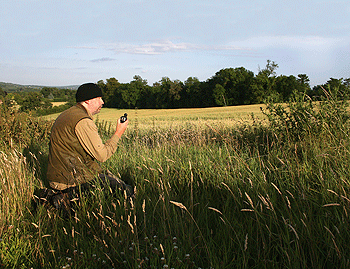Calling the shots

Mid-July to early August is always the most exciting period in the roe stalking calendar, and is even better than those first trips into the woods in April. Why should this be? Well, the roe are in love and rutting activities between buck and doe give you a slightly better chance of harvesting a buck. Roe are not particularly vocal animals, only really breaking the silence of their ordinary stealthy existence when barking at intruders, be they rivals or humans straying too close. But come July alarmed young fawns can be heard feep-ing for their mothers, while does that are coming into oestrus become far more vocal in a bid to entice a suitor.
Feep-ing does can be very hard to identify and are often mistaken for other animals. Their high-pitch resonating squeak can be used to reassure fawns, tell younger bucks to back off or, more importantly, act as a lure for a big roebuck.
By mimicking these subtle calls of the fawn or doe, you can increase your chances of having a roebuck standing before you, but choosing a call and ensuring you know how to use it correctly are two entirely different things.
Field use
Once you have all the kit, don?t think for a moment that a few toots on the call will bring a gold medal roebuck bounding out of the woods towards you. Choosing the right location is key ? you should always be downwind as far as possible, or at least be in a position where deer will feed or cross ahead or at 90 degrees from your position. Try to have your back to a track or fence line, where deer are less likely to sneak up from behind you.
I like to sit with my back against a tree or, more often than not, nestled in among nettles or long grass where I have a clear view across a field or woodland glade. Give yourself a bit of legroom ? at least 100 yards of ground in front of you, as sometimes a buck can come in running and this dead ground will give you time to assess the beast and prepare for a shot. If you are in the thick of it, you may panic and shoot before you?re ready.
Morning or evening, it never seems to make much difference, though if there is a full moon, the roe will have been rutting for most of the night and are likely to be found in the morning woods looking for a buck. Almost instantly, a yearling doe came bounding out of the wood and stood looking in my direction, partly in surprise and partly to check whether a different doe was in the vicinity. I slowly raised the rifle and waited motionless in case a buck was in close pursuit behind the doe. Alas, no and she soon lost interest and slipped away.
I was just about to call again when my eye was drawn to a mature doe, head down and panting, coming down a tramway in the wheat, with a nice roebuck following along behind her. But as they neared to 120 yards the doe veered right.
If the buck followed, I would lose them among the crops. I quickly gave a couple of sharp feeps on the Hubertus and the buck skidded to a stop, as did the doe, and both looked my way. The doe did her best to restart the chase but a few more subtle feeps and the buck was slowly edging his way towards me ? maybe the grass was greener over here?
At 70 yards and rested on the sticks I was confident the buck was right to harvest and a neck shot above the crops would be assured. As the Tikka?s trigger broke, a 150gr Nosler AccuBond bullet struck its mark and the buck dropped instantly, and away bounded a bemused doe. It doesn?t always happen like this, but sometimes a mixture of luck, circumstance and the confidence not to over-call can reap their rewards.
Practice and perseverance
Roe calling can be a fickle endeavour and a bit of an art, but perseverance and practice are key to getting the tone, duration and delay of the call right. That?s the fun of calling roebuck in. If it was easy there would be no sport, but when it all comes together and a doe comes running towards you followed by the buck of your dreams, you will be hooked.
Calling adds a another tool to your arsenal for stalking roe. I have called roe most months by mimicking does calling yearlings, yearlings calling siblings, and barking in April to rile up bucks trying to establish their dominance. Calls are cheap but you should practise at home first, otherwise a deer?s backside may be all you?ll ever see on your stalks.








